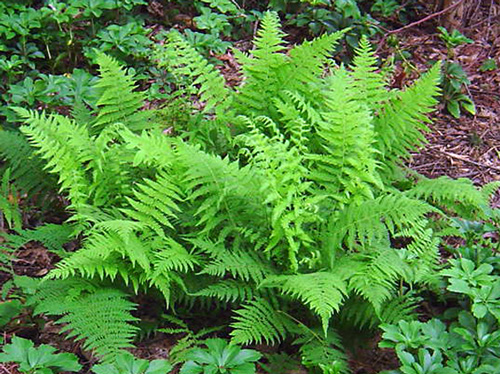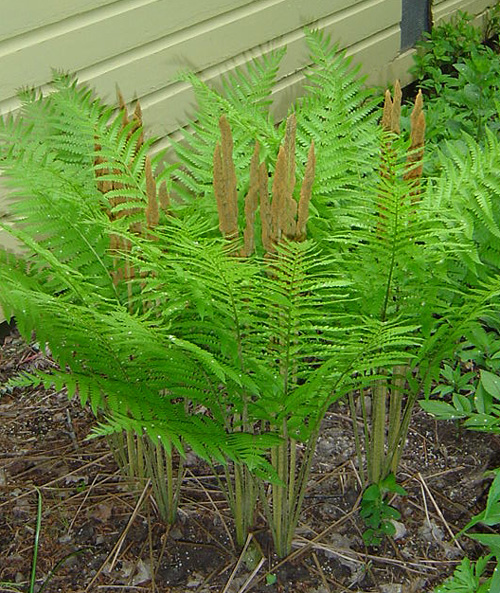One of the joys of spring is watching ferns unfurl. The fronds start with small fuzzy arcs in the early spring, just poking their little heads above the crown of the plant and slowly growing upward and unfurling like the unwinding of a spring. When I see these fiddleheads, I know spring is really here.
Unfortunately ferns get very little attention as a garden perennial. In most books about perennials, they aren’t even mentioned. This is probably because they don’t have flowers or seeds and somehow people don’t think of them as perennials. They are in fact perennials, reliably returning each year to add beauty, texture and even color to our gardens.
Many people have the misconception that ferns are difficult to grow. This stems from the fact that they seem exotic, tropical, and not appropriate for our cooler climate. That couldn’t be further from the truth. The north east has numerous varieties of native ferns in its woods and meadows. If they grow successfully on their own, how hard can it be to grow a few in our gardens?
Like with any plant, you need to match the conditions in your garden to the requirements of the fern. They are perfect for a moist shady location, but that is not the only suitable habitat. Some can tolerate quite a bit of sun and others will handle dryer soil. All the ferns love leaf mold mulch, which is logical considering in nature they grow in the woods. The important thing is doing your homework before you purchase a fern and find out just what conditions they prefer.
One of the advantages of growing ferns is their almost year round interest. From the spring unfurling, through the summer’s lush textured foliage, to the beautiful caramel and amber colors of the fall, ferns add a depth to the garden that cannot be achieved with the more traditional blossoming perennials whose flowers come and go so quickly. The green provides a resting spot for the eyes as well as making the colors of the blooms around them stand out.
Ferns have been growing for more than 300 million years! In most depictions of dinosaurs there are ferns in the background. In fact, in prehistoric times, they were a dominant part of the vegetation. Today there are about 12,000 species of fern worldwide and more than 50 species native to the Northeast.
The following are some native ferns that will grow well in our area. Adding native ferns is a good way to contribute to the sustainability of your landscape. The ferns mentioned below are generally available at nurseries and will grow well in our area. One of the most important features of ferns is deer don’t like them! That alone is reason to try a few.
Christmas fern (Polystichum acrostichoides): If you want to try just one fern, the Christmas fern has the most adaptable requirements. It prefers rich, moist soil but will also tolerate dry soil. Christmas fern likes shade but will take partial sun if the soil is moist enough. One of the things setting this fern apart is the fronds are evergreen so you have the deep green color all winter. Christmas fern is not invasive. The clump slowly gets larger, staying 12 to 24 in. tall.
Ostrich fern (Matteuccia struthiopteris): This is a large fern, 24 to 72 inches tall and brings a stunning verticality to the landscape. Ostrich fern loves moist shade or part sun and will even tolerate occasional standing water. It’s ideal along a stream or near a pond. The fronds emerge from a central crown that looks like a dark brown, dead clump on the ground in the winter. This is the fern that has the tastiest fiddleheads and are as prized as asparagus in the spring. Ostrich fern can become invasive sending out new underground shoots so don’t put it somewhere it doesn’t have a little room to spread. If they do spread too much they are easy to dig up and share with a friend.
Lady fern (Athyrium filix-femina): Lady fern is one of the most common ferns in wooded areas of western New York and also one of the easiest to grow. It prefers moist, loamy soil and shade to partial sun. Lady fern stays 16-36 inches tall and it has an attractive, lacy appearance. It forms a lovely amorphous clump that won’t take over your garden and adds a feathery texture.
Cinnamon fern (Osmunda cinnamomea): This is a spectacular, rounded clump forming fern that gets 30 to 60 inches tall. Its fiddleheads are hairy and very decorative in spring. The spore fronds turn cinnamon colored when mature, hence its name. Unfortunately they don’t persist through the season but die back after releasing their spores, but they’re a show-stopper while they last. Cinnamon fern prefers moist to wet soil.
Maidenhair fern (Adiantum pedatum): The maidenhair fern is one of our most beautiful native ferns, always lovely in a landscape. Its fronds unfold on wiry, delicate black stems. The green fronds form a double-sided swirl of leaves from the top of the stem. Maidenhair ferns grow 12 to 20 inches tall and prefer partial to full shade. They thrive in moist well-drained soil. This is not a fern that will grow in standing water. One of my favorite features of maidenhair fern is the deep burgundy color they turn in fall. Stunning!
Sensitive fern (Onoclea sensibilis): This is one of the ferns that will do well in full sun if the conditions are moist. It will also do very well in shade with normal garden soil. Sensitive fern has a pale green color and a single stemmed triangular frond with segments more coarsely divided. The spore fronds persist and look like little round balls on a stick. For this reason they are often used in fall arrangements. Sensitive fern grows to a height of 12 – 36 inches tall, and spreads readily given the right conditions.
Interrupted fern (Osmunda claytoniana): The growth habit of this fern is striking. It forms an upright clump similar to an ostrich fern but the spores appear as dark sacks mid-way up the stem, hence the name. People always ask what it is when they see it in my garden. Interrupted fern grows 24 to 48 inches tall and can tolerate relatively dry shade to partial shady conditions.
If you have the appropriate spot, give one of our native ferns a try. They will reward you with beauty throughout the growing season and for years to come.
Lyn Chimera is a master gardener with Erie County Cornell Cooperative Extension.
Views: 5








